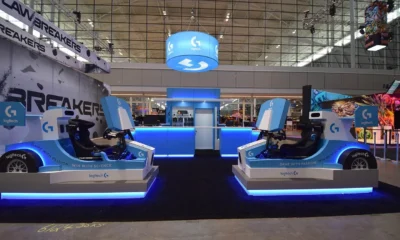Technology
Hi target 北斗基准站 Beidou Base Stations: The Complete Guide to Precision GNSS Positioning

Introduction
The global surveying and mapping industry has witnessed remarkable technological advancement over the past decade, with Chinese innovations playing an increasingly vital role. Among the leading companies driving this transformation is hi target 北斗基准站, a pioneering manufacturer that has established itself as a trusted name in professional surveying equipment worldwide.
Hi-Target’s expertise extends across various positioning technologies, but their Beidou base station solutions represent a particularly significant achievement. These systems leverage China’s indigenous satellite navigation system to deliver high-precision positioning capabilities that rival traditional GPS-based solutions. For surveying professionals, construction engineers, and mapping specialists, understanding the capabilities and applications of Hi-Target Beidou base stations has become essential for staying competitive in an evolving marketplace.
This comprehensive guide explores everything you need to know about Hi-Target Beidou base stations, from their technical specifications to real-world applications and implementation strategies.
Understanding Beidou Base Stations and Precise Positioning
Beidou base stations serve as ground-based reference points that enhance the accuracy of satellite positioning systems. Unlike standalone GNSS receivers that rely solely on satellite signals, base stations create a network of known positions that can correct atmospheric interference, satellite orbit errors, and other factors that typically reduce positioning accuracy.
The Beidou Navigation Satellite System (BDS), developed by China, provides global coverage through a constellation of over 35 satellites. When combined with properly configured base stations, this system can achieve centimeter-level accuracy for positioning applications. Hi-Target has developed specialized base station equipment that maximizes the potential of Beidou signals while maintaining compatibility with other GNSS constellations including GPS, GLONASS, and Galileo.
Base stations continuously receive satellite signals and compare the calculated positions with their known coordinates. The difference between these values represents the positioning error at that specific time and location. This correction data is then transmitted to nearby rovers or mobile receivers, allowing them to achieve significantly improved accuracy.
Technical Architecture of Hi-Target Beidou Base Stations
Hi target 北斗基准站 Beidou base stations incorporate advanced multi-frequency receivers capable of tracking signals across multiple satellite constellations simultaneously. The core hardware typically includes high-gain antennas optimized for Beidou frequencies, powerful signal processing units, and robust communication modules for data transmission.
The antenna design plays a crucial role in system performance. Hi-Target base stations feature precision-engineered antennas with excellent multipath rejection capabilities and stable phase center characteristics. These antennas maintain consistent performance across varying environmental conditions, ensuring reliable operation in challenging field environments.
Processing units within Hi-Target base stations run sophisticated algorithms that filter raw satellite observations and generate precise correction data. These systems can handle hundreds of satellite observations per second while maintaining real-time performance. Advanced error modeling techniques account for ionospheric delays, tropospheric effects, and satellite clock errors to maximize correction accuracy.
Communication capabilities vary depending on the specific model and application requirements. Hi-Target base stations support multiple data transmission methods including radio modems, cellular networks, and internet protocols. This flexibility allows operators to choose the most appropriate communication method for their specific deployment scenario.
Applications and Use Cases
Hi target 北斗基准站 Beidou base stations serve diverse industries requiring high-precision positioning. In construction projects, these systems enable accurate layout work, grade control, and structural monitoring. Large infrastructure developments benefit from the ability to maintain consistent accuracy across extensive project sites while reducing survey time and costs.
Agricultural applications have embraced precision farming techniques enabled by hi target 北斗基准站 base stations. Farmers use RTK-corrected positioning for automated steering systems, variable rate application of fertilizers and pesticides, and precise field mapping. The consistent accuracy provided by base stations translates directly into improved crop yields and reduced input costs.
Mining operations rely on Hi-Target Beidou base stations for fleet management, ore grade control, and safety monitoring. The ability to track equipment positions with centimeter accuracy enables optimized haul routes, improved productivity, and enhanced safety protocols. Underground mining applications benefit from the system’s ability to extend precise positioning into areas where satellite signals are unavailable.
Surveying and mapping professionals use Hi-Target base stations for topographic surveys, boundary determination, and GIS data collection. The technology significantly reduces the time required for traditional surveying tasks while improving accuracy and reliability. Archaeological surveys, environmental monitoring, and infrastructure inspection all benefit from the enhanced positioning capabilities.
Key Benefits of Hi-Target Beidou Base Stations
Cost efficiency represents one of the most compelling advantages of Hi-Target Beidou base stations. Organizations can establish their own positioning networks without relying on expensive commercial correction services. The initial investment in base station equipment typically pays for itself within months through reduced operational costs and improved productivity.
Reliability and independence from external services provide operational advantages in remote locations or areas with limited infrastructure. Hi-Target base stations operate autonomously once properly configured, ensuring consistent performance regardless of cellular coverage or internet connectivity. This self-sufficiency proves especially valuable for projects in developing regions or remote locations.
Customization capabilities allow organizations to optimize system performance for specific applications. Hi-Target base stations can be configured with various correction data formats, transmission protocols, and coverage areas to match unique operational requirements. This flexibility ensures optimal performance across diverse use cases and geographic regions.
Integration with existing workflows and equipment streamlines adoption for organizations already using GNSS technology. Hi-Target base stations are compatible with industry-standard protocols and can work alongside existing surveying instruments and software systems. This compatibility reduces training requirements and simplifies the transition to higher-precision positioning.
Real-World Success Stories
A major highway construction project in Southeast Asia deployed hi target 北斗基准站 Beidou base stations to maintain positioning accuracy across a 200-kilometer corridor. The system provided consistent centimeter-level accuracy for machine control, survey layout, and quality assurance throughout the multi-year project. Project managers reported 30% reductions in survey time and significant improvements in construction quality compared to previous projects using traditional methods.
An agricultural cooperative in South America implemented hi target 北斗基准站 base stations to support precision farming operations across 50,000 hectares of cropland. The system enabled automated steering for planting and harvesting equipment while supporting variable rate application of inputs. The cooperative documented 15% increases in crop yields and 25% reductions in input costs during the first year of operation.
A mining company in Africa established a Hi-Target Beidou base station network to support open-pit operations and exploration activities. The system provided positioning support for autonomous haul trucks, drill rig positioning, and geological mapping. The implementation resulted in 20% improvements in haul truck efficiency and enhanced safety through better equipment tracking.
Competitive Analysis and Market Position
Hi-Target Beidou base stations compete with established manufacturers including Trimble, Leica, and Topcon in the global GNSS market. While traditional leaders maintain strong positions in developed markets, Hi-Target offers compelling advantages in cost-effectiveness and Beidou constellation optimization.
Technical performance comparisons show Hi-Target base stations achieving accuracy levels comparable to premium alternatives while offering significant cost savings. The company’s focus on Beidou compatibility provides advantages in regions where the Chinese constellation offers superior coverage or performance compared to GPS.
Service and support capabilities have improved substantially as Hi-Target has expanded its global presence. The company now maintains regional offices and authorized dealers in major markets, providing local technical support and training services. This expanded support network addresses one of the traditional challenges faced by customers considering Hi-Target equipment.
Innovation and development efforts continue to drive improvements in Hi-Target base station technology. Recent firmware updates have added support for new signal types, improved interference rejection, and enhanced communication capabilities. The company’s commitment to ongoing development ensures customers benefit from continued performance improvements.
Implementation and Maintenance Best Practices
Site selection for Hi-Target Beidou base stations requires careful consideration of sky visibility, multipath sources, and communication requirements. Optimal locations provide unobstructed views of the sky while minimizing reflective surfaces that could cause signal interference. Stable mounting platforms and reliable power sources are essential for consistent long-term operation.
Installation procedures should follow Hi-Target’s detailed guidelines to ensure optimal performance and reliability. Proper antenna mounting, cable routing, and grounding techniques prevent common issues that could compromise system accuracy. Initial setup and calibration require precise measurement of antenna positions and careful verification of system operation.
Regular maintenance schedules help ensure continued reliable operation of Hi-Target base stations. Routine tasks include antenna cleaning, cable inspection, and performance verification using known reference points. Firmware updates should be applied as released to take advantage of performance improvements and new features.
Troubleshooting common issues requires understanding of both hardware and software components. Hi-Target provides comprehensive diagnostic tools and technical documentation to support field personnel. Common problems include communication failures, power issues, and environmental interference that can typically be resolved through systematic troubleshooting procedures.
Future Innovations and Technology Trends
Emerging technologies are driving continued evolution in base station capabilities and applications. Hi-Target is actively developing next-generation systems that incorporate artificial intelligence for improved error modeling and correction generation. These advances promise even higher accuracy and reliability for demanding applications.
Multi-constellation optimization represents a key area of development as additional satellite systems become fully operational. Hi-Target base stations are being enhanced to take full advantage of Beidou-3, GPS modernization, and expanded Galileo and GLONASS constellations. This multi-constellation approach will provide improved availability and accuracy in challenging environments.
Integration with emerging technologies including IoT sensors, edge computing, and 5G communications will expand the capabilities of future base station systems. Hi-Target is exploring these technologies to create more intelligent and capable positioning networks that can support a broader range of applications.
Cloud-based services and remote monitoring capabilities are becoming standard features for professional base station deployments. Hi-Target is developing comprehensive cloud platforms that enable remote system monitoring, performance analysis, and predictive maintenance capabilities.
Maximizing Your Investment in Precision Positioning
Hi-Target Beidou base stations represent a proven solution for organizations requiring high-precision positioning capabilities. The combination of advanced technology, cost-effective pricing, and comprehensive support makes these systems an attractive choice for diverse applications ranging from construction and agriculture to mining and surveying.
Success with Hi-Target base stations requires careful planning, proper implementation, and ongoing maintenance. Organizations that invest time in understanding system capabilities and optimizing deployment strategies typically achieve excellent returns on their investment through improved productivity and reduced operational costs.
The future of precision positioning continues to evolve rapidly, with new technologies and capabilities emerging regularly. Hi-Target’s commitment to innovation and development ensures that customers investing in their base station technology will benefit from continued improvements and new capabilities as they become available.
Frequently Asked Questions
How accurate are Hi-Target Beidou base stations compared to GPS-only systems?
Hi-Target Beidou base stations typically achieve centimeter-level accuracy, which is comparable to high-end GPS base stations. In regions where Beidou satellites provide better coverage or geometry, accuracy may actually exceed GPS-only solutions.
What is the typical range for Hi-Target Beidou base station corrections?
The effective range depends on the specific model and environmental conditions, but typically extends 10-15 kilometers for RTK applications. Network RTK configurations can extend coverage significantly beyond single base station limits.
Are Hi-Target base stations compatible with equipment from other manufacturers?
Yes, Hi-Target base stations support industry-standard correction formats including RTCM and can work with rovers and mobile receivers from most major manufacturers.
What ongoing costs are associated with operating Hi-Target Beidou base stations?
Primary ongoing costs include power consumption, communication fees (if using cellular data), and periodic maintenance. These costs are typically much lower than subscription fees for commercial correction services.
How long does it take to set up and calibrate a new Hi-Target base station?
Initial setup and calibration typically require 2-4 hours depending on site conditions and operator experience. Most of this time is spent on precise antenna positioning and initial system verification.
Technology
Why AI Employee Tracking Alone Can’t Build a Thriving Company

Imagine running a small business where every keystroke, email, and coffee break is tracked by an algorithm. Sounds efficient, right? But when I helped a friend streamline her startup’s operations in 2025, we quickly learned that relying solely on AI employee tracking—like the best employee tracking software—can backfire. While tools like Controlio offer powerful insights into productivity, they miss the human spark that makes a company truly great. Let’s explore why AI tracking alone isn’t enough and what really drives a thriving workplace.
The Limits of AI Tracking: Numbers Over Nuance
AI employee tracking tools, like the Controlio app, are designed to boost efficiency by monitoring metrics such as time spent on tasks or app usage. They’re fantastic for spotting patterns—say, identifying when your team’s bogged down by repetitive work. But here’s the catch: they reduce people to data points. When my friend’s startup leaned too heavily on tracking software, her team felt like cogs in a machine, not valued contributors.
Research shows that excessive surveillance can tank morale. A 2024 Cornell study found employees under AI monitoring reported higher stress and lower productivity compared to those with human oversight. Why? Algorithms lack context. They can’t tell if someone’s late because they were helping a colleague or if a long email thread was a creative brainstorm. Over-reliance on AI risks alienating your team, stifling the very innovation you’re trying to foster.
Human Connection: The Heart of a Great Company
Great companies aren’t built on dashboards alone—they thrive on trust, collaboration, and shared purpose. I saw this firsthand when my cousin’s catering business hit a rough patch. Instead of doubling down on tracking tools, she hosted weekly team huddles to share ideas and celebrate wins. The result? Her staff felt heard, and turnover dropped by 30% in six months.
AI can’t replicate the empathy of a manager who notices a team member’s off day and offers support. It can’t spark the camaraderie of a spontaneous lunchroom chat that leads to a breakthrough idea. Building a strong company culture means prioritizing relationships over reports. Encourage open communication, mentorship, and team-building—elements no algorithm can quantify.
Creativity and Innovation: Beyond the Algorithm’s Reach
AI tracking excels at measuring output but struggles with intangibles like creativity and emotional intelligence. When I worked with a local design agency, we noticed their AI tool flagged “unproductive” hours spent sketching or brainstorming. Yet those moments birthed their best campaigns. Over-focusing on metrics can suffocate the creative freedom that drives innovation.
A 2025 McKinsey report highlights that companies fostering experimentation and collaboration outperform those obsessed with efficiency metrics. Give your team room to take risks—whether it’s prototyping a bold idea or debating a new strategy. Tools like Controlio can track time, but they can’t measure the spark of a game-changing idea born over coffee.
Trust vs. Surveillance: Striking the Right Balance
Constant monitoring erodes trust, and trust is the glue of any great company. Employees who feel watched like hawks are less likely to take initiative or share honest feedback. A Reddit thread from 2024 echoed this, with workers venting about AI tracking making them feel “on edge” and less loyal to their employers.
When my friend’s startup introduced transparent policies about how tracking data would be used—like improving workflows, not punishing pauses—her team relaxed. Use AI tools to empower, not police. Share insights with employees, involve them in decisions, and set clear boundaries. For example, use Controlio to optimize schedules, but pair it with regular check-ins to show you value their input, not just their output.
Ethical Concerns: Avoiding Bias and Burnout
AI isn’t neutral—it can amplify biases or push employees toward burnout. A 2025 Business Insider report noted that poorly designed AI tracking systems may unfairly flag certain groups, like remote workers, due to inconsistent data patterns. Plus, an overemphasis on productivity metrics can lead to exhaustion, with 60% of surveyed employees reporting stress from constant monitoring.
To counter this, regularly audit your AI tools for bias and ensure they align with your company’s values. Promote work-life balance with policies like flexible hours or mental health days. My friend learned this the hard way when her team’s morale dipped—she countered it with wellness programs, and productivity soared.
Final Note: Blend Tech with Heart for Lasting Success
AI employee tracking, like the Controlio app, is a powerful tool for streamlining operations, but it’s not a magic bullet. Great companies are built on trust, creativity, and human connection—qualities no algorithm can fully capture. My friend’s startup flourished when she balanced tech insights with genuine care for her team, proving that people, not just data, drive success.
In 2025, embrace AI as a helper, not a boss. Use tools to spot inefficiencies, but invest in mentorship, open dialogue, and a culture where employees feel valued. That’s the recipe for a company that doesn’t just survive but thrives. Ready to strike that balance? Start exploring smarter ways to blend tech and heart today.
Technology
“Duster SUV: Complete Guide to Features, Specs, Safety, and Buying Tips”

Introduction
The word Duster brings to mind a simple, sturdy SUV many people trust. This car feels practical and honest. It fits families, adventurers, and daily drivers alike. People praise its space, its simple tech, and its low cost to own. In this article, I explain what makes the Duster special. I use clear, short sentences that are easy to read. I give real facts, helpful tips, and plain advice. I show numbers where they matter and share trusted insights. Read on for design notes, engine choices, safety facts, buying tips, and six common questions. By the end, you will know whether this model suits your life and budget.
What it is
The Duster is a compact SUV that blends value with practicality. It started as a no-nonsense crossover people could afford. Over time, it grew more refined while keeping its core strengths. Today it comes in several versions for many markets. You can find models with mild-hybrid help or classic petrol engines. The Duster aims to offer a roomy cabin without high costs. It targets buyers who want a solid SUV without fancy frills. That clear purpose shaped its design and its price strategy. Many drivers see it as an honest car that gives you what you need.
Design and styling
The look of this compact SUV mixes toughness and neat lines. It keeps a broad stance and raised wheel arches. The front often shows a strong light design and simple grille work. Inside, the layout favors durable materials and sensible storage. The exterior has roof bars and protective cladding for outdoor use. Designers focused on useful features over delicate trims. That choice helps keep repair costs low over time. If you want flashy leather and soft touch everywhere, this might not be it. But if you want a rugged, honest SUV ready for trips, it fits the bill.
Engines and powertrains
You can pick from small petrol engines and mild-hybrid setups. Some markets also see a larger 2.0 petrol and 4×4 option. Engine output varies by region and trim level. The simplest petrol is easy to maintain and quite fuel friendly. The mild-hybrid choice helps with short town runs and saves fuel. For tougher terrain, a 4×4 option offers extra traction and control. Manuals, CVTs, and automatic options appear depending on model year. Always check exact engine details where you live before you buy. Each version balances performance and fuel economy differently.
Fuel economy and efficiency
This SUV can be quite frugal, depending on the engine you pick. Smaller petrols often return good fuel efficiency in mixed driving. Hybrid versions claim better urban economy and lower emissions. The mild-hybrid systems help reduce engine load at idle and in slow traffic. Real-world economy will change with load, terrain, and driving style. Drivers who favor calm acceleration often see the best numbers. If you plan long highway trips, choose an engine tuned for steady cruising. Official figures give a useful baseline when you compare trims.
Off-road capability and ground clearance
Raised ride height makes this model useful on rough tracks and muddy roads. Some trims list over 200 mm of ground clearance for easy approach. Four-wheel drive models include terrain selectors for snow, mud, and sand. The suspension is tuned for resilience rather than sporty handling. Protective skid plates help against rocks and bumps on trails. That setup gives confidence for weekend camping and farm access roads. Still, it is a compact SUV, not a heavy-duty truck. Match expectations to the terrain you’ll tackle most often.
Interior space and practicality
The cabin focuses on smart storage and easy cleaning for busy lives. Boot volume ranges from mid to large capacity, depending on trim and engine. With rear seats folded, the load area grows to take longer items. The double-floor and compartments help keep gear tidy on long trips. Front and rear passengers get sensible legroom for the class. Infotainment supports phone mirroring in many trims for maps and music. Materials lean toward durable plastics and simple switches for reliability. This makes the interior practical for family life and outdoor adventures.
Safety and ratings
Safety equipment varies by market and trim level. Many versions now come with driver aids like lane assist and emergency braking. Older models had fewer safety features, but recent upgrades improved this area. Buyers should look for multiple airbags, stability control, and strong crash ratings. Always compare the fitment of safety tech between trims before you buy. Choosing a version with active safety aids makes daily driving more secure. Families especially benefit from these modern protections.
Ownership and running costs
One big strength is the low cost of ownership compared to rivals. Insurance and repair parts tend to be cheaper for this model. Service intervals are reasonable and many mechanics know the platform. Fuel bills depend on engine and driving habits, but smaller engines keep costs down. Resale value varies by region and trim, so check local used prices. Warranty length also differs by country. If you plan to buy used, ask for full service history and check for rust or heavy off-road wear. Overall, the Duster aims to be affordable to run and repair.
Trim levels and options
Manufacturers offer a clear set of trims from basic to well-equipped. Basic trims give the essentials to keep the price low. Mid trims add nicer infotainment, alloy wheels, and comfort items. Top trims may include leather-effect seats and advanced driver aids. Some regions add unique packs like camping gear or cargo versions. You can often choose bar-style roof racks and protective mats. Decide which features you need before picking a trim. That saves money and avoids paying for extras you will not use.
How it compares with rivals
Against similar compact SUVs, the Duster wins on price and practicality. Some rivals offer fancier cabins or sharper handling. Others will have stronger dealer networks or better long-term resale. If you want rugged looks and simple tech, this model often leads. If you prefer premium fit and more silence inside, look at other brands. Compare boot size, fuel numbers, and safety kit when you shop. Test drives across a few models reveal which feels best for your needs.
Maintenance, tips, and common issues
Routine checks keep this SUV reliable for many years. Watch for common wear items like brake pads and suspension bushes. Keep the air filter fresh if you drive dusty roads often. For long trips, check belts and fluid levels before you leave. Choose genuine parts when possible, but good aftermarket parts can save money. If the car has a CVT, follow the service rules for transmission oil. Joining owner groups can give you tips on common fixes. These small steps help avoid surprises and control repair costs.
Customization and accessories
Owners often add roof racks for bikes and kayaks. Boot liners and mudflaps protect the paint and the interior. For camping, simple tents and sleep packs make trips easier. All-weather mats help keep the cabin clean in winter. Some dealers sell protection packs with skid plates and light guards. Choose only tested accessories that fit factory mounts. Proper accessories raise the car’s usefulness without harming safety. A small investment in the right bits makes the vehicle far more versatile.
Environment and hybrid tech
Newer mild-hybrid and hybrid setups reduce fuel use in town. The hybrid option often lets the engine rest for short electric-only runs. This suits stop-and-go traffic in cities well. Hybrid tech also helps reduce emissions and fuel bills. Still, the fuel gains depend heavily on how you drive. Long highway trips may show less benefit than urban driving. If your commute is mostly city, a hybrid variant can cut costs. Always review real-world test results to compare engines before buying.
Best use cases and who should buy it
The Duster fits families who want space and low costs. It serves people who enjoy weekend trips off the beaten track. Small business owners like cargo versions for city deliveries. First-time SUV buyers get easy driving and affordable upkeep. Buyers who want full luxury or sporty handling should consider other models. If you value honest design, big boot space, and rugged style, this one is sensible. Matching the trim to your needs ensures good value for the money.
Conclusion — is it right for you?
In short, the Duster blends value, space, and rugged practicality. It is not the quietest or plushest cabin in its class. But it will carry people, luggage, and pets without fuss. If low running costs matter, it can be a smart choice. Read the spec sheet carefully in your country before you buy. Test drive the same engine and trim you plan to purchase. Check local prices and dealer support for your area. If you like simple, practical design and honest value, this SUV may fit your life.
FAQs
Q1 — What is the best engine for daily driving?
A small petrol or mild-hybrid often works best for daily use. These choices give low city fuel use. They feel calm and save money on regular runs. If you carry heavy loads often, choose the bigger petrol. For mixed town and highway trips, a mild-hybrid balances economy and comfort.
Q2 — How much boot space does it offer?
Boot space depends on trim and engine choices. Typical figures start around mid-hundreds of litres. Folding the rear seats adds a lot of cargo room. Official brochures list exact litres for each version. Always confirm the details for the model in your region.
Q3 — Is the four-wheel drive model worth it?
Four-wheel drive helps if you face mud, snow, or steep tracks. It adds weight and usually lowers fuel economy. For mostly city driving, a 2WD version is often enough. Choose 4×4 if you need traction on rough ground frequently.
Q4 — Are parts and servicing expensive?
Parts and servicing tend to be affordable compared to premium rivals. Many mechanics know the platform well. Warranty coverage varies by country. Regular servicing and modest care keep costs predictable.
Q5 — How safe is the model?
Safety kit and crash scores differ by year and market. Some older models had fewer aids, but newer versions include more. Look for emergency braking, lane assist, and multiple airbags. Confirm the exact features on the trim you plan to buy.
Q6 — Should I buy new or used?
New gives full warranty and the latest gear. Used saves money but needs careful checks. Ask for service records and inspect for off-road wear. If budget is tight, a certified pre-owned unit can be a balanced choice.
Technology
What is Zivechatz? Full Review, Features, and How to Use It
-

 Technology3 years ago
Technology3 years agoIs Camegle Legit Or A Scam?
-

 Travel3 years ago
Travel3 years agoNEW ZEALAND VISA FOR ISRAELI AND NORWEGIAN CITIZENS
-

 Technology3 years ago
Technology3 years agoRNDcoin: Korea’s first blockchain project and a world-class cryptocurrency
-

 Uncategorized3 years ago
Uncategorized3 years agoAMERICAN VISA FOR NORWEGIAN AND JAPANESE CITIZENS
-
Lifestyle1 year ago
A Guide to Silverdaddies: What You Need to Know
-

 Fashion1 year ago
Fashion1 year agoGoda Perfume Reviews: Is It Worth Your Investment?
-

 Health3 years ago
Health3 years agoHealth Benefits Of Watermelon
-

 Home Improvement9 months ago
Home Improvement9 months agoArtificial Grass Designs: Perfect Solutions for Urban Backyards

















